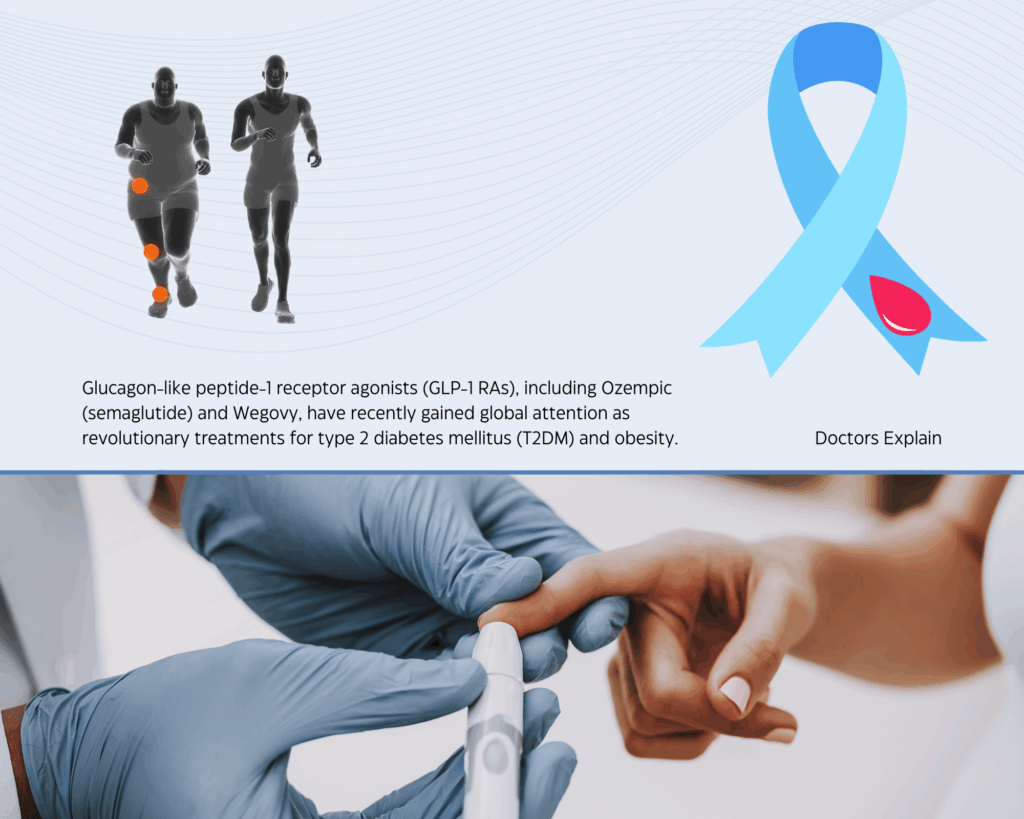
The UglyBeautiful Truth About GLP-1 Drugs (Ozempic, Wegovy): A Game Changer or a Short-Term Fix?
- May 26, 2025
- 1 Like
- 720 Views
- 0 Comments
Abstract
Glucagon-like peptide-1 receptor agonists (GLP-1 RAs), including Ozempic (semaglutide) and Wegovy, have recently gained global attention as revolutionary treatments for type 2 diabetes mellitus (T2DM) and obesity. While clinical trials suggest profound benefits in glycemic control and weight loss, concerns about long-term efficacy, safety, accessibility, and the socio-economic impact remain. This paper critically examines the current evidence, benefits, and limitations of GLP-1 drugs from a global health perspective. We explore whether these agents represent a sustainable paradigm shift or merely a temporary solution within a complex metabolic and societal context.
Introduction
The global burden of obesity and type 2 diabetes has reached pandemic proportions, with over 650 million adults obese and approximately 537 million living with diabetes worldwide (World Health Organization [WHO], 2022). GLP-1 receptor agonists (GLP-1 RAs), including semaglutide marketed as Ozempic and Wegovy, have emerged as promising pharmacotherapies. These agents mimic endogenous incretin hormones, enhancing insulin secretion, suppressing glucagon, slowing gastric emptying, and promoting satiety, which collectively reduce blood glucose and body weight (Drucker, 2018).
However, despite enthusiasm, questions remain about the sustainability of GLP-1 RA benefits, potential adverse effects, and whether their high cost and need for continuous administration limit their impact in diverse healthcare settings worldwide. This paper reviews the “ugly” and “beautiful” truths about GLP-1 drugs to determine if they are a genuine game changer or a short-term fix.
Mechanism of Action and Clinical Benefits
GLP-1 is an incretin hormone secreted by intestinal L-cells postprandially. It enhances glucose-dependent insulin secretion and exerts anorectic effects via central nervous system pathways (Nauck & Meier, 2018). Synthetic GLP-1 RAs, including semaglutide, provide a longer half-life enabling weekly dosing.
Glycemic Control
In patients with T2DM, GLP-1 RAs reduce HbA1c by approximately 1–1.5% compared to placebo or standard therapy (Zhang et al., 2021). Semaglutide demonstrated superior efficacy in the SUSTAIN and PIONEER trials, with improved glycemic control and cardiovascular benefits (Marso et al., 2016; Husain et al., 2019).
Weight Loss
Wegovy, a higher-dose semaglutide formulation, has shown weight reduction of up to 15% of baseline body weight in clinical trials such as STEP 1 (Wilding et al., 2021). These results surpass those of previous weight-loss medications, establishing GLP-1 RAs as the most effective pharmacological obesity treatment currently available.

The Beautiful Truth: A Paradigm Shift
Cardiovascular and Metabolic Benefits
GLP-1 RAs not only improve glycemic control and weight but also reduce major adverse cardiovascular events (MACE) in high-risk populations (Marso et al., 2016). This dual benefit offers a substantial improvement in morbidity and mortality outcomes globally.
Improved Quality of Life
By enabling sustained weight loss and better glucose regulation, patients experience improved quality of life, self-esteem, and reduced comorbidities (Rubino et al., 2021).
The Ugly Truth: Challenges and Limitations
Long-Term Safety and Efficacy
Despite promising short-term data, long-term effects remain uncertain. Adverse events include gastrointestinal symptoms, pancreatitis risk, and possible thyroid C-cell tumors, although rare (American Diabetes Association [ADA], 2023). Furthermore, weight regain is common after discontinuation, suggesting these drugs might function as a lifelong therapy rather than a cure (Kushner et al., 2020).
Accessibility and Cost
The high cost of GLP-1 RAs limits accessibility, especially in low- and middle-income countries (LMICs). This disparity raises ethical concerns about global health equity and prioritization (Mahal et al., 2022).
Sociocultural Considerations
Medication alone cannot address underlying behavioral, environmental, and socioeconomic determinants of obesity and diabetes. Without integrated lifestyle interventions and public health measures, reliance on GLP-1 drugs may overshadow more sustainable solutions (Ng et al., 2014).
Discussion
GLP-1 RAs represent a significant advancement in treating T2DM and obesity, offering substantial clinical benefits. However, framing them as a “game changer” risks oversimplifying complex chronic diseases with multifactorial etiologies. Their role may be best viewed as an important component within a comprehensive management framework that includes lifestyle changes, education, and health policy reform.
Addressing cost and accessibility, particularly in LMICs, requires international cooperation and innovative pricing models. Furthermore, longitudinal real-world studies are crucial to clarify long-term safety and effectiveness globally.
Conclusion
The “uglybeautiful” truth about GLP-1 drugs like Ozempic and Wegovy is that while they offer transformative benefits, they are not a panacea. They currently function more as effective short-to-medium-term therapies requiring lifelong use rather than cures. Their optimal role lies within multi-pronged approaches combining pharmacotherapy, lifestyle modification, and systemic health interventions to tackle the global burden of obesity and diabetes equitably and sustainably.
References
American Diabetes Association. (2023). Standards of Medical Care in Diabetes—2023. Diabetes Care, 46(Supplement_1), S1–S154. https://doi.org/10.2337/dc23-Sint
Drucker, D. J. (2018). Mechanisms of action and therapeutic application of glucagon-like peptide-1. Cell Metabolism, 27(4), 740–756. https://doi.org/10.1016/j.cmet.2018.03.001
Husain, M., Birkenfeld, A. L., Donsmark, M., et al. (2019). Oral semaglutide and cardiovascular outcomes in patients with type 2 diabetes. New England Journal of Medicine, 381(9), 841-851. https://doi.org/10.1056/NEJMoa1901118
Kushner, R. F., Calanna, S., Davies, M., et al. (2020). Weight regain and health status after withdrawal of semaglutide: STEP 4 trial. Obesity, 28(11), 2035-2043. https://doi.org/10.1002/oby.23021
Mahal, A., Acevedo-Garcia, D., Thorpe, R. J. Jr., & Lê-Scherban, F. (2022). Equity and access to medications for obesity and diabetes in low- and middle-income countries. The Lancet Global Health, 10(2), e199-e200. https://doi.org/10.1016/S2214-109X(21)00534-2
Marso, S. P., Bain, S. C., Consoli, A., et al. (2016). Semaglutide and cardiovascular outcomes in patients with type 2 diabetes. New England Journal of Medicine, 375(19), 1834-1844. https://doi.org/10.1056/NEJMoa1607141
Ng, M., Fleming, T., Robinson, M., et al. (2014). Global, regional, and national prevalence of overweight and obesity in children and adults during 1980–2013: a systematic analysis. The Lancet, 384(9945), 766-781. https://doi.org/10.1016/S0140-6736(14)60460-8
Nauck, M. A., & Meier, J. J. (2018). Incretin hormones: Their role in health and disease. Diabetes, Obesity and Metabolism, 20(Suppl 1), 5-21. https://doi.org/10.1111/dom.13129
Rubino, D., Abrahamsson, N., Davies, M., et al. (2021). Effect of continued weekly subcutaneous semaglutide vs placebo on weight management in adults with overweight or obesity: The STEP 4 randomized clinical trial. JAMA, 325(14), 1403–1413. https://doi.org/10.1001/jama.2021.3175
Wilding, J. P. H., Batterham, R. L., Calanna, S., et al. (2021). Once-weekly semaglutide in adults with overweight or obesity. New England Journal of Medicine, 384(11), 989-1002. https://doi.org/10.1056/NEJMoa2032183
World Health Organization. (2022). Obesity and overweight. https://www.who.int/news-room/fact-sheets/detail/obesity-and-overweight
Zhang, Y., Guo, L., & Wang, X. (2021). Efficacy and safety of GLP-1 receptor agonists in type 2 diabetes: A systematic review and meta-analysis. Diabetes Therapy, 12(8), 2203–2215. https://doi.org/10.1007/s12325-021-01743-7



Leave Your Comment